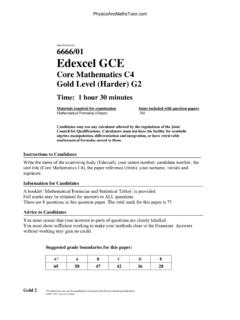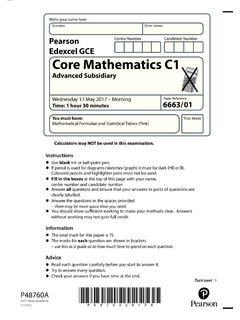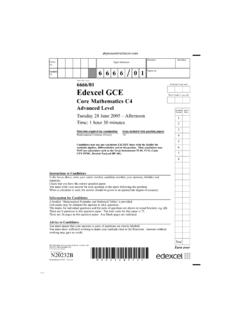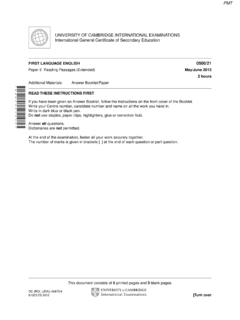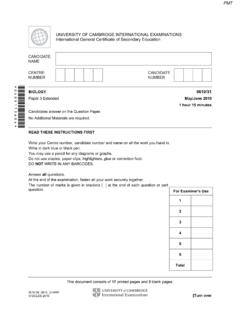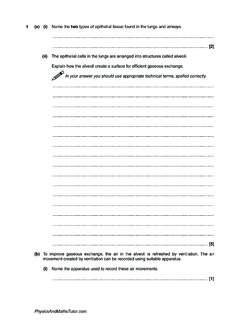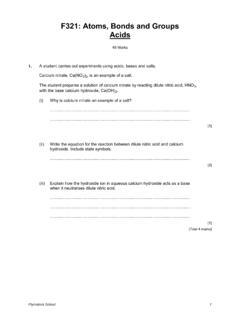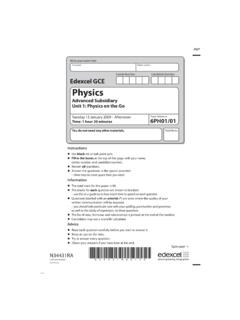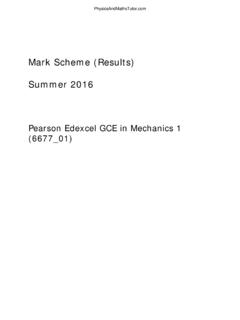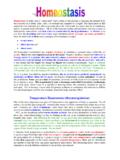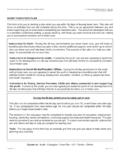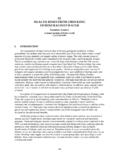Transcription of [1] J - pmt.physicsandmathstutor.com
1 1 The maintenance of a stable body temperature is an important aspect of homeostasis in endotherms. This is known as thermoregulation. (a) (i) State where the core body temperature is monitored.. [1]. (ii) Name the type of sensory cell in the skin that detects changes in environmental temperature.. [1]. (iii) Name the corrective homeostatic mechanism that works to restore any changes in body temperature to the normal range.. [1]. (b) Endotherms respond in different ways to changes in environmental temperature. Some of these responses are listed below: J secretion of adrenaline K sweating L shivering M contraction of erector pili muscles (attached to base of hairs). N curling up O finding shade P vasoconstriction of arterioles near to skin surface Use the letters, J to P, to identify: (i) the responses that conserve heat.
2 [1]. (ii) the responses that cool the body.. [1]. (iii) a physiological response that generates heat.. [1]. (iv) a behavioural (not physiological) response to a decrease in environmental temperature.. [1]. (c) Different endotherms have evolved different physiological and behavioural adaptations to assist with temperature control. Explain how each of the following adaptations help the animal to control its body temperature. (i) Elephants have large, thin ears that they move backwards and forwards when hot.. [2]. (ii) Penguins living in cold climates have shunt' blood vessels. These shunt vessels link arterioles carrying blood towards their feet with small veins that carry blood away from their feet.. [1]. [Total: 10]. 2 A group of microorganisms called slime moulds includes the species Dictyostelium discoideum.
3 The life cycle of D. discoideum is shown in Fig. single-celled 1 bacterium individuals if food becomes scarce 4. fruiting body 2. cAMP. attraction released 3 grex Fig. 1 When plenty of food is available this slime mould exists as single-celled individuals which feed and reproduce asexually. The slime mould cells feed on bacteria. The slime mould cells are attracted to folic acid which has been released by the bacteria. 2 When food becomes scarce the slime mould cells release a chemical (cAMP) which attracts other slime mould cells. 3 The slime mould cells then group and stick together to form a multicellular mass called a grex. The grex moves in a coordinated way in search of a more suitable environment. As the grex moves, the cells release the chemical DIF. DIF causes some cells to become stalk cells and others to become spore cells.
4 4 When the grex reaches suitable conditions, it forms a fruiting body consisting of a stalk and spores. These spores are released and develop into new, individual, slime mould cells. (a) (i) Suggest the type of cell division used by D. discoideum for reproduction during stage 1 of its life cycle.. [1]. (ii) At what stage of the life cycle does differentiation begin? .. [1]. (b) Communication and cooperation between cells is essential for the survival of D. discoideum. (i) State the correct term for communication between cells.. [1]. (ii) Describe two examples of communication between cells that occur during the life cycle of D. discoideum.. [2]. (iii) The plasma membranes of the slime mould cells are specially adapted for communication. Using the information on page 12, and your biological knowledge, suggest how the plasma membrane of D.
5 Discoideum is adapted for cell communication.. [2]. (c) Individual cells of D. discoideum can divide once every hour. A grex may consist of 100 000. individual cells. Calculate how many hours it would take for one cell to produce enough cells to form a grex. Answer = .. hours [1]. [Total: 8]. 3 (a) The control of blood glucose is a very important aspect of homeostasis . (i) Explain what is meant by the term homeostasis .. [2]. (ii) Describe how negative feedback is used to control blood glucose concentration. In your answer, you should use appropriate technical terms, spelt correctly.. [6]. (b) A 55 year old man visited the doctor and was newly diagnosed with diabetes. The doctor initially recommended to the man that he should change his diet to cut out excess carbohydrate, including sugars such as glucose and make a further appointment to check on his progress.
6 At this second appointment, however, it was discovered that the dietary changes had not been effective, which was unexpected. It turned out that the man had a form of diabetes that required daily hormone injections to control his blood sugar concentration. Using only the information given above, state how this man's form of diabetes is similar to: (i) Type 1 diabetes .. [1]. (ii) Type 2 diabetes.. [1]. [Total: 10]. 4 (a) Fig. represents a molecule of ATP. base X. Z. sugar Y. Fig. (i) Name the parts of the ATP molecule labelled X, Y and Z. X .. Y .. Z .. [3]. (ii) With reference to Fig. , describe and explain the role of ATP in the cell.. [3]. (b) Fig. is an electron micrograph of a mitochondrion from an animal cell. A. Fig. (i) Name the structure labelled A.. [1]. (ii) Name the specific process that is carried out by structure A in the mitochondrion.
7 [1]. (c) Some animals conserve energy by entering a state of torpor (a short period of dormancy), in which they allow their body temperature to fall below normal for a number of hours. In an investigation into torpor in the Siberian hamster, Phodopus sungorus, the animal's respiratory quotient (RQ) was measured before and during the period of torpor. The respiratory quotient is determined by the following equation: RQ = volume of carbon dioxide produced volume of oxygen consumed in the same time RQ values for different respiratory substrates have been determined and are shown in Table Table substrate RQ. carbohydrate lipid protein (i) Initially, the RQ value determined for the hamster was , but as the period of torpor progressed, its RQ value decreased to What do these values suggest about the substrates being respired by the hamster during the period of the investigation?
8 [3]. (ii) Describe the way in which an endothermic animal, such as a mammal, normally prevents its body temperature from decreasing when the external temperature decreases. In your answer, you should use appropriate technical terms, spelt correctly.. [5]. [Total: 16].
